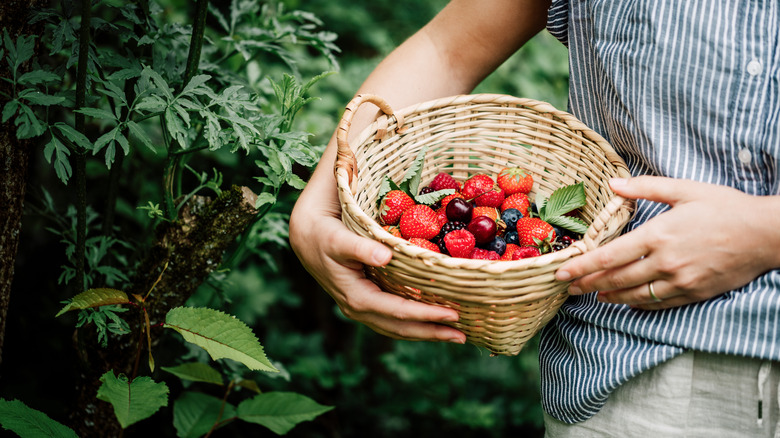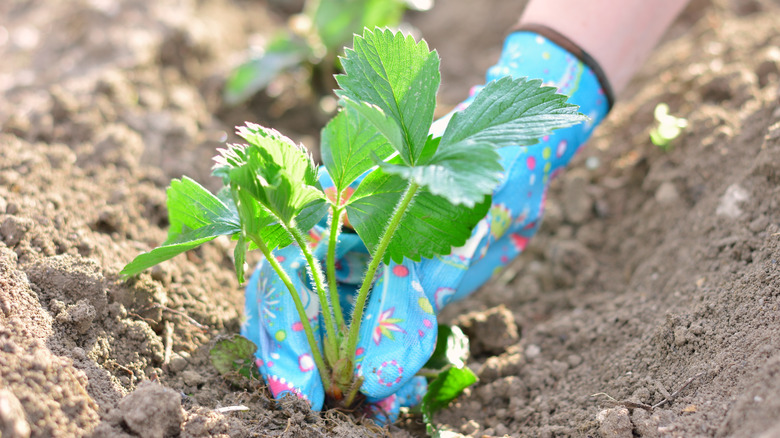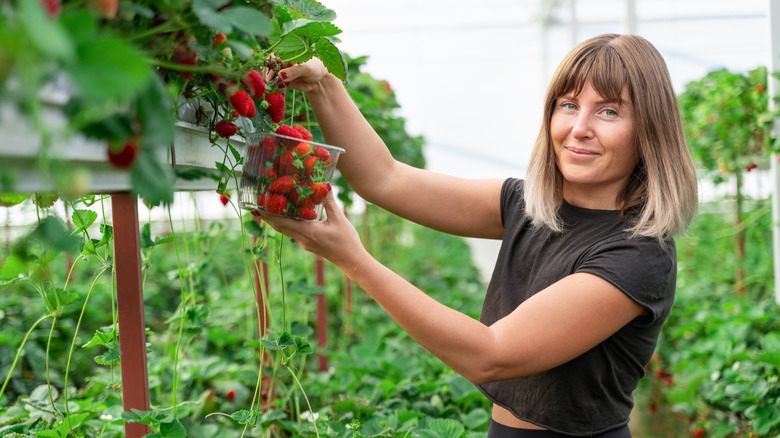This Garden Tip Is The Secret To A Luscious Strawberry Harvest
Strawberries are a popular choice for gardeners due to their ease of growth and numerous benefits. Conveniently, they are relatively low-maintenance plants that can be grown in various climates and soil types. They are also adaptable to both garden beds and containers, making them suitable for small spaces in your home or even urban gardens as opposed to just traditional garden spaces. Additionally, strawberries are perennial plants, meaning they can produce fruit for several years with proper care, making them a reliable crop that will return each year. That all being said, like with any plant, strawberries benefit from consistent care and a spring planting to yield a luscious harvest.
Planting strawberries in the spring is beneficial for several reasons. First, strawberries are cold-hardy plants that can tolerate cooler temperatures, but they also require a certain amount of chilling hours to break dormancy and initiate fruit production. By planting in the spring, gardeners can ensure that the plants have received enough chilling hours during the winter months, which promotes healthy growth and abundant fruiting. Secondly, spring planting allows the strawberry plants to establish their root systems before the hot summer months. This gives them a better chance of surviving and thriving during the heat, as they will have a strong foundation to draw nutrients and water from the soil. Finally, planting in the spring provides strawberries with a longer growing season. They'll have more time to develop and ripen their fruits, resulting in larger and sweeter berries.
How to plant strawberries
To plant strawberries in traditional gardens in the springtime, start by choosing a sunny location with well-drained soil. Dig a hole that is wide and deep enough to accommodate the roots of the strawberry plant. Place the plant in the hole, making sure that the crown (where leaves meet the roots) is level with the soil surface. Gently backfill the hole with soil, firming it around the roots. It's recommended to space the plants about 12 to 18 inches apart to allow for proper air circulation. Water the plants thoroughly after planting and continue to water regularly, keeping the soil consistently moist but not waterlogged. Traditional garden planting allows strawberries to spread and form runners, which can result in a larger strawberry patch over time. It also provides ample space for the plants to grow and spread their roots, resulting in healthy, productive plants.
Alternatively, you can plant strawberries in containers at least 12 inches deep. Fill the container with a well-draining potting mix, leaving an inch of space at the top. Place the strawberry plant in the center of the container, making sure that the crown is level with the soil surface. Gently backfill the container with soil. Water the plant thoroughly after planting and continue to water regularly, allowing the excess water to drain out of the container. Containers provide the advantage of portability, allowing gardeners to move the plants to optimal sunlight or protect them from extreme weather conditions.
How to care for your growing strawberries
In addition to planting your strawberries in the spring, there are other steps you can take to foster a luscious harvest. Sunlight is crucial for the growth and fruiting of strawberry plants. These plants thrive in full sun, which means they need at least 6 to 8 hours of direct sunlight each day. Choose a sunny location in your garden, or place your containers in an area that receives ample sunlight. Lack of sunlight can result in weak plants and smaller, less flavorful berries.
Watering is another essential aspect of strawberry care. These plants require consistent moisture, but it is important to avoid overwatering. Overwatering can lead to root rot and other diseases. Water your strawberries deeply once or twice a week, depending on the weather conditions. During hot and dry periods, you may need to water more frequently. Mulching around the plants can help retain moisture and regulate soil temperature. It is also important to water the plants at the base, avoiding wetting the leaves, as this can promote fungal diseases.
Finally, it's important to only allow three to four runners per strawberry plant to increase berry yields because runners, which are long stems that grow from the mother plant, divert energy and nutrients away from fruit production. By limiting the number of runners, the plant can focus its resources on producing larger and more abundant berries. This allows for better fruit development and leads to a higher yield.


